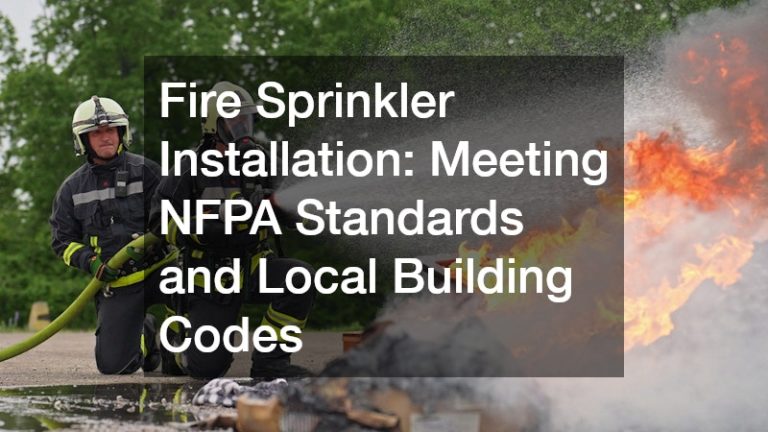Fire Sprinkler Installation: Meeting NFPA Standards and Local Building Codes
Fire sprinkler systems are an essential component of building safety, acting as the first line of defense against fire incidents. Ensuring these systems adhere to the National Fire Protection Association (NFPA) standards and local building codes is crucial for their effective performance.
NFPA standards serve as a benchmark for safety, providing detailed guidelines on designing, installing, and maintaining fire sprinkler systems. Local building codes, while often aligning with NFPA standards, may introduce specific requirements tailored to regional needs and conditions.
Failure to comply with these standards and codes can lead to hefty fines, legal issues, or, worse, inadequate protection in case of a fire. Therefore, understanding and adhering to both sets of regulations is imperative for anyone involved in the installation of fire sprinklers.
How Do You Ensure Compliance With NFPA Standards?
Understanding NFPA Standards
NFPA standards related to fire sprinkler systems include NFPA 13, NFPA 13D, and NFPA 13R, which cover different types of installations based on the occupancy and structure. These codes are regularly updated to incorporate new safety measures and technological advancements.
It is essential for installers and building owners to stay informed about these updates to ensure compliance. Resources such as NFPA’s official website, training programs, and publications can be invaluable in understanding these complex codes.
Using these standards as a framework not only ensures regulatory compliance but also enhances the safety and effectiveness of sprinkler systems. By following the detailed guidelines provided in these standards, installers can guarantee optimal system performance.
Steps to Achieve Compliance
Achieving compliance with NFPA standards begins with thorough planning and design, focusing on the specific needs and characteristics of the building. Engaging a certified fire protection engineer can be beneficial in evaluating these factors and laying down a solid installation plan.
Once the design is approved, obtaining permits and collaborating with local authorities is a critical next step. It is vital to maintain open communication channels with these bodies to ensure the specific requirements are met during the installation process.
The final step involves meticulous execution and testing of the installed system to verify its compliance with NFPA standards. Regular inspections and maintenance should also be scheduled to ensure the system remains in top working condition.
How Are Local Building Codes Different from NFPA Standards?
Variations in Local Building Codes
While NFPA standards provide a broad framework, local building codes may introduce specific requirements based on regional fire risks and environmental conditions. These variations can include differences in installation materials, system pressure specifications, or even water supply requirements.
Understanding these local nuances is crucial for successful fire sprinkler installation. Failure to comply with these unique requirements can lead to fines, legal challenges, or potential hazards in case of fire.
Local amendments to standard codes may also involve additional safety features or testing protocols dictated by recent regional fire incidents. Staying informed and in compliance involves keeping a pulse on both NFPA standards and evolving local regulations.
Strategies for Navigating Local Codes
Successfully navigating and complying with local building codes requires a proactive approach, including establishing relationships with local regulatory bodies. Regularly attending public consultations, code workshops, and networking events can provide valuable insights into upcoming changes.
Leveraging the expertise of local consultants or engineers familiar with regional codes can also be advantageous. Their experience and local knowledge can aid in identifying potential compliance issues early in the planning stages.
Additionally, maintaining meticulous documentation of design, installation, and testing processes can help address any compliance concerns raised by local authorities. Proper record-keeping is a crucial part of demonstrating adherence to both NFPA standards and local building codes.
What Are the Common Challenges in Fire Sprinkler Installation?
Technical Challenges
Technical challenges in fire sprinkler installation often stem from the complexity of integrating systems into existing structures without sacrificing functionality. Ensuring adequate water pressure and system responsiveness requires careful planning and execution.
Retrofitting older buildings poses additional challenges, as original structural designs may not accommodate modern sprinkler systems. In such cases, tailored solutions need to be developed to ensure both safety and structural integrity.
Advancements in technology also introduce new complications, requiring installers to continually update their skills and knowledge. Staying abreast of industry innovations enables installers to implement cutting-edge solutions efficiently.
Regulatory Challenges
Regulatory challenges encompass difficulties in navigating the myriad of local amendments to NFPA codes, each introducing distinct compliance requirements. Keeping current with changes in legislation demands ongoing education and awareness of industry updates.
Understanding how these regulations impact different stages of installation, such as planning, material selection, and system testing, is critical. Local variations in code interpretation can further complicate this process, necessitating careful attention and preparation.
Overcoming these challenges involves collaboration with industry peers, government officials, and regulatory bodies, pooling knowledge to address and adapt to evolving standards. Through developing industry relationships, those involved in installations can better manage and anticipate regulatory shifts.
Conclusion
Adhering to NFPA standards and local building codes is non-negotiable when it comes to fire sprinkler installation. Each element of the planning and execution must prioritize compliance to ensure safety, legality, and efficacy.
By understanding the intricacies of these regulations and implementing robust installation strategies, building owners and installers can mitigate potential risks. Effective navigation of both NFPA standards and local codes is a keystone of successful sprinkler system deployment.
The ongoing education and collaboration with experts and authorities are pivotal in achieving compliance and optimizing fire safety infrastructure. Ultimately, the commitment to safety through compliance with these standards and codes protects lives, property, and investments.




